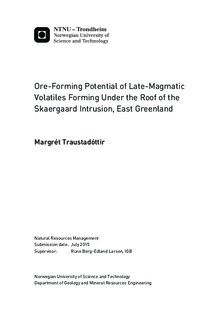Ore-Forming Potential of Late-Magmatic Volatiles Forming Under the Roof of the Skaergaard Intrusion, East Greenland
Master thesis
Permanent lenke
http://hdl.handle.net/11250/2350470Utgivelsesdato
2015Metadata
Vis full innførselSamlinger
Sammendrag
Volatiles can have a substantial influence on the constrains and genesis of ore deposit, but are not generally stored in the system afterwards. Small pockets of fluid can however be stored as fluid inclusions. Therefore the study of fluid inclusions has contributed to the extensive understanding of the behaviour of volatiles in different geological settings, and to the conditions during the formation of the mineral that entrapped the fluid inclusion. The intent of this research is to study the late-magmatic aqueous fluids in the Skaergaard layered gabbro. Both the gabbroic pegmatites and the granophyre masses in the intrusion coexisted with an aqueous solution with the same chemical composition. By using microthermometry it is possible to measure the temperatures at which phase changes happen within a fluid inclusion, which consequently enables the evaluation of the chemical composition and the evolution of the system. Additionally, a geochemical analysis was performed to further assess the magma chamber processes during the crystallization of the intrusion. Samples collected during previous expeditions to Skaergaard were used, and fieldwork was conducted at Vestrahorn to obtain a better understanding of the granophyre and gabbroic pegmatite. The Skaergaard intrusion drove its own meteoric-hydrothermal circulation system during subsolidus cooling. This resulted in an alteration of the mineral assemblage and possible re-equilibration of the fluid inclusions, without any considerable changes in the chemical composition of the aqueous volatiles stored within the fluid inclusions. The better preserved fluid inclusions correlates with the previous research of the LS, which indicate increased pressure during crystallization as the Skaergaard intrusion was progressively buried by flood basalt. It is suggested that the re-equilibration of fluid inclusion occurred while the system was dominated by hydrostatic pressure, at a sub-solidus conditions.
